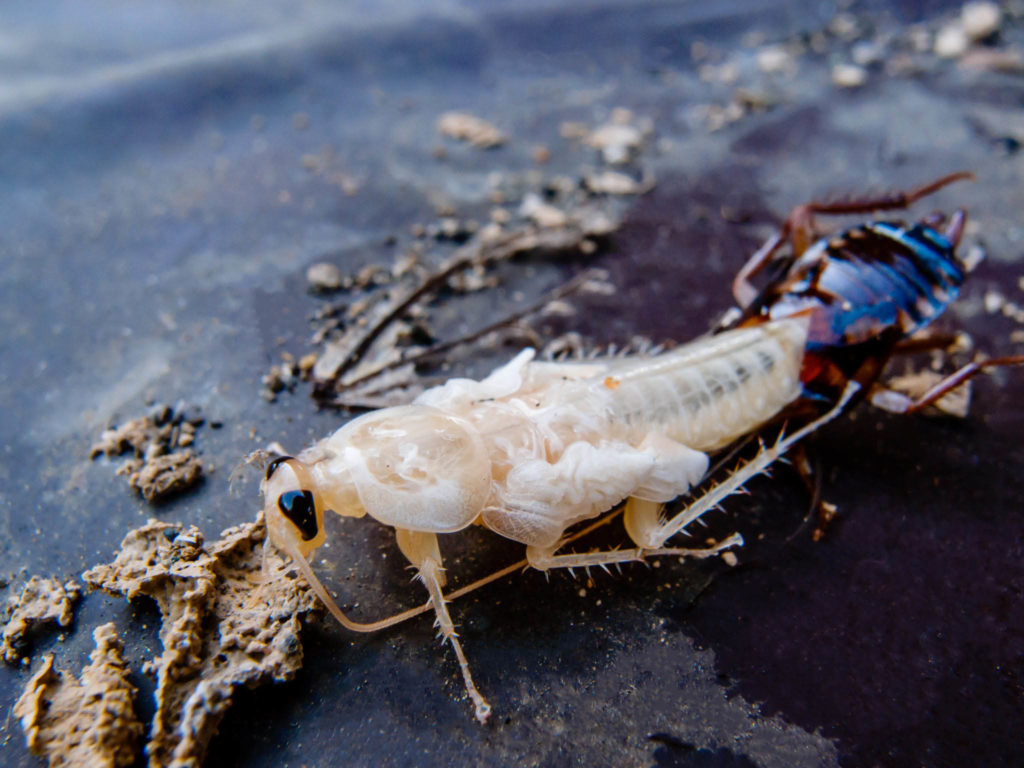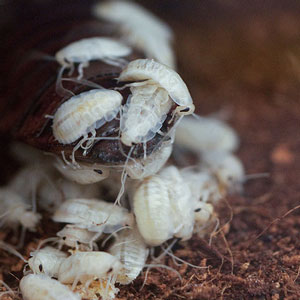You’re at home relaxing when you suddenly see something strange and sinister on the floor.
A cockroach. But unlike a regular cockroach, this one looks even more like an alien–it’s white.
Questions suddenly flood your mind:
Is this an albino of some kind?
Is this an auspicious or disastrous event?
Should I kill it or will it bite me?…
In this post, we’ll go over all the questions you have about these white critters, beginning from what they are to what you should do about them.
Are White Cockroaches Albino Cockroaches?
No. White cockroaches are not albinos.
While people do refer to white roaches as Albino roaches, they are not an albino species as we define them.
Albinism happens when there’s a defect in one of the genes that produce or distribute melanin.
This defect interferes with the production of melanin, causing a partial or complete loss of pigmentation.
As a result, these animals will have a much paler skin tone compared to other members of their species.
Albinos in the animal kingdom are rare.
To become an albino, animals must inherit one or more of their parent’s mutated genes.
White cockroaches are not albinos.
And while you may not have seen one before, they’re not rare. Not even close.
What Causes White Cockroaches?

White cockroaches are white because of a transition phase called molting.
Molting is an essential part of a cockroach’s life cycle.
During this phase, juvenile roaches, called nymphs, shed their exterior so that they can grow larger.
The result? White cockroaches.
After molting, nymphs lose their exoskeleton along with most of the pigmentation in their bodies.
Unlike real albinos, white roaches’ pigmentation is typically restored in less than 24 hours.
This color restoration happens through a chemical reaction in the cockroach’s body.
How Often Do Cockroaches Turn White?
Molting periods vary per species.
But most roaches will go through 4-6 molting periods throughout their lifetime.
Below is a list with the number of molts and time before adulthood for some of the most popular cockroaches.
- German Cockroaches – 4-6 molts in 3-6 months.
- Asian Cockroaches – 6-8 molts in 2-3 months.
- Brown Banded Cockroaches – 4-6 times in 9-12 months.
- Wood Cockroaches – 5-7 molts in 1-2 years.
- American Cockroaches – 6-8 molts in 1-2 years.
- Smokey Brown Cockroach – 9-12 molts in 1-2 years.
- Oriental Cockroach – 6-8 molts in 1-2 years.
The number of molts that a cockroach experiences depend on two things.
- Average size of a cockroach species.
- Availability of food and water.
Larger roaches go through more molting periods than smaller species.
When roaches have plenty of food and water they will spend less time between molts and reach adulthood much faster.
Most indoor roaches go through a molting phase between 100 and 200 days.
This process stops once a roaches reach adulthood.
Why Is a White Cockroach So Rare?
White cockroaches aren’t rare.
You’re just unlikely to see them.
This is because white cockroaches are vulnerable and have to be extra careful.
When roaches shed their exoskeleton, they lose the ability to move fast (Imagine trying to run without your bones).
White roaches only have their soft shells to rely on, making them easy preys.
To avoid being eaten, roaches seek shelter when ready to molt.
They stay inside their shelter until their exoskeleton hardens and darkens.
So, you’ll most likely only see them once they look like regular roaches again.
If I’ve Seen One in My Home, What Does It Mean?

If you see a white cockroach in your home, you likely have a growing infestation.
Female cockroach eggs typically have between 30-40 nymphs.
If you see a white cockroach, there are at least 40 other cockroaches in your home and likely more than that.
Even if there are only 40 cockroaches in your home, cockroaches reproduce quickly.
For example, within a year, a female German cockroach can produce around 400 babies within 100 days.
If you see a white cockroach it is likely close to reaching full adulthood and gaining the ability to reproduce.
White cockroaches also point to a nearby harborage area.
When cockroaches are in their “white” phase, they hide and don’t move much.
If you see a white cockroach out in the open, they likely ventured from their hiding spot on accident.
For example, if you see a cockroach in a kitchen drawer, it is likely if you inspected more thoroughly, you would find more under the counter top or in other drawers.
Why Could White (Albino) Cockroach Be Dangerous?
Albino roaches look scary. I know.
But, like most roaches, they are unlikely to bite you.
There are reports of cockroaches biting humans.
But that is a rare event.
Reports of cockroaches biting people happen only in two places.
The first is a place with massive infestations.
In this situation, there is insufficient food for the cockroaches, so they resort to chewing on fingernails or eyelashes.
Most people will never experience such a massive infestation, let alone live in one.
That said, white cockroaches are still dangerous in other ways.
Like other roaches, white cockroaches can transmit disease and pathogens in your home.
They can cause salmonella and infections such as staphylococcus and streptococcus.
According to the World Health Organization (WHO), cockroaches can also cause dysentery, diarrhea, cholera, and typhoid fever.
Cockroaches are also known to cause allergic reactions to humans.
These reactions are especially worrisome for those with asthma.
Research by the Asthma and Allergy Foundation (AAFA) has shown that the enzymes found in excrement, shedding body parts, eggs, and saliva can trigger both allergic reactions and asthma attacks.
What Should I Do if I See a White Cockroach?
You certainly do not want to take seeing a white cockroach lightly.
When spotted, you should take action immediately.
If you want to solve this on your own, there are a few steps you can take.
The first step to eliminating cockroaches is identifying the species and level of infestation in your home.
You can do this by using sticky traps in popular hiding places for cockroaches.
Once you identify the type of cockroach, use their characteristics and preferences to eliminate them.
The next step is to apply gel bait near common hiding spots.
Gel bait is most effective when it is inside crevices that cockroaches could.
The next step is to apply dust bait in hard to reach areas such as in wall voids or behind cabinet floorboards.
The final step is to use insect growth regulators or IGRs.
IGR’s will stop the life cycle of cockroaches and help stop the infestation from growing.
But if you have a serious infestation, you should call a professional to help get rid of them for good.
Roaches are notorious for being difficult to get rid of, so an expert’s help can be a godsend.
Pest control experts are trained in roach control and have years of experience dealing with situations like yours.
Calling them they can save you plenty of time, money, and stress.
